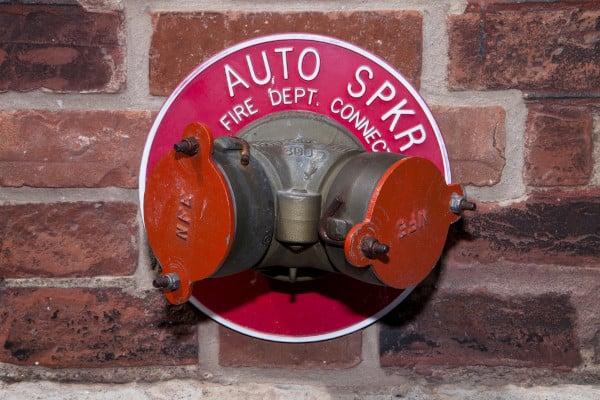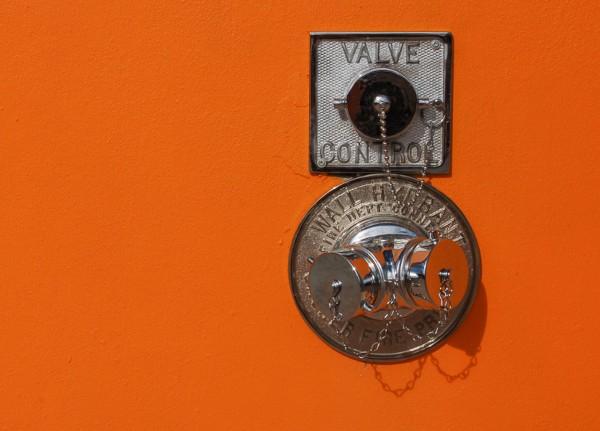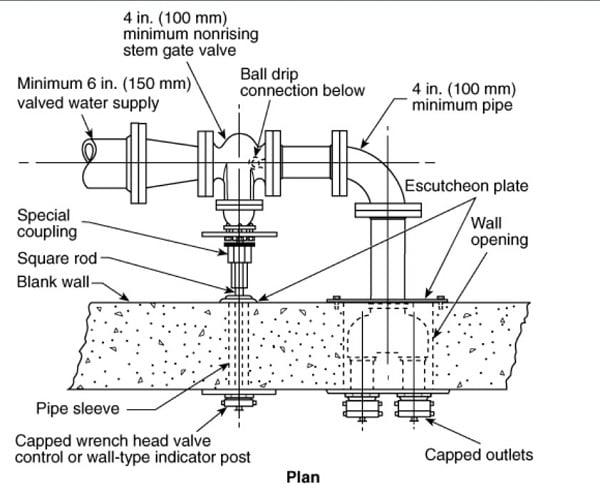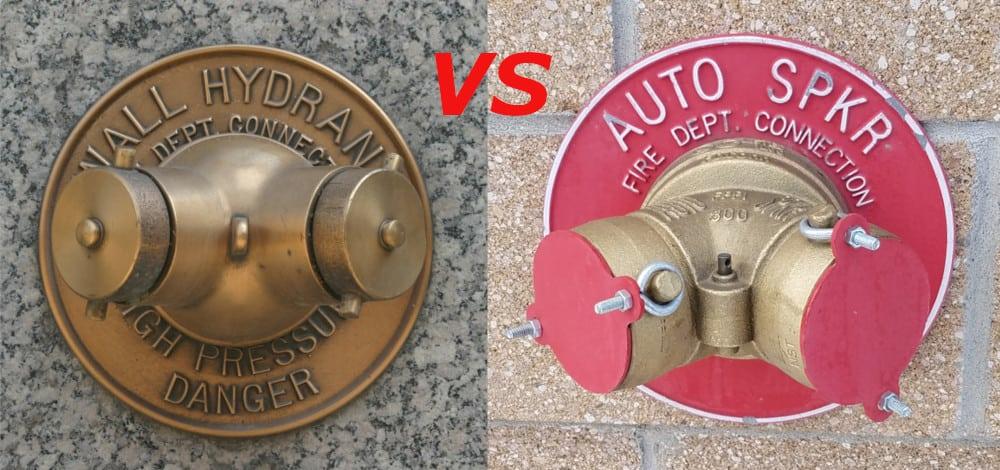Wall hydrants resemble FDCs, but their function is exactly the opposite
While fire department connections (FDC) and wall hydrants often look similar, featuring capped hose connections mounted in walls, they have major differences. The biggest distinction is that pressurized water comes out of a wall hydrant, and pressurized water goes into an FDC.
A wall hydrant is basically like other fire hydrants but built into a wall instead of freestanding. It is used as a water source for firefighting efforts.
An FDC, on the other hand, is a way for firefighters to supply water to a building’s sprinkler or standpipe system from a hose connected to a fire engine pump (usually supplied by a nearby hydrant).
Here’s our more detailed guide to this distinct but sometimes confused equipment, including their functions, significant components, relevant NFPA standards, and maintenance requirements:
- What is an FDC, and how does it work?
- The FDC inspection, testing, and maintenance (ITM) basics
- What is a wall hydrant, and how does it work?
- The ITM basics for wall hydrants
If you require fire hydrant equipment, QRFS has caps, hydrant and hose wrenches, PIV wrenches, and all the pitot gauges, nozzles, and other equipment for flow tests. If you need new FDCs or parts to maintain existing ones, QRFS has you covered with caps and plugs, swivels, FDC bodies, and identification plates.
What is an FDC, and how does it work?
If a building has a standpipe system—a network of pipes that provides water to firefighting hoses inside a structure—or an automatic fire sprinkler system, it likely has an FDC. Exceptions in sprinklered buildings include single-story structures of 2,000 square feet or less, those in very remote areas, and structures served by a high-capacity deluge system.
The FDC is the fire department’s access point for pumping water into these systems, either as the main supply or to provide supplemental pressure.
At the scene of a structure fire, firefighters use FDCs like this:
- The fire department runs a hose from a nearby fire hydrant to their fire engine’s pump.
- A second hose (or third or more) is connected to the FDC supplying the sprinkler system or standpipe.
The additional flow and pressure from the pump can augment or entirely supply the pressurized water used by standpipes and fire sprinkler systems. For more info, check out this explanation of when FDCs provide the water supply or supplemental pressure.

An FDC includes these basic parts:
- A snoot (threaded hose connection) is mounted on a swivel so it turns freely, allowing for easy hose connections. The snoot should have a gasket to ensure a positive, water-tight seal, plus a cap to protect from damage and debris.
- When two or more hose connections are present, a clapper prevents water from coming out of unused holes.
- An automatic drain inside the walls prevents freezing.
- A check valve keeps wet standpipe or sprinkler system water from flowing out of the FDC.

The specific installation rules for FDCs are found in NFPA 13: Standard for the Installation of Sprinkler Systems (currently in its 2022 edition) and NFPA 14: Standard for the Installation of Standpipe and Hose Systems (2024 edition).
FDC inspection, testing, and maintenance
Inspection, testing, and maintenance (ITM) are essential in fire protection, and FDCs are no exception.
Like most elements of water-based fire protection systems, the complete ITM tasks and schedule for fire department connections are detailed in NFPA 25: Standard for the Inspection, Testing, and Maintenance of Water-Based Fire Protection (currently in the 2023 edition).
However, briefly, they consist of:
- Quarterly inspections verifying the presence and good condition of all the parts mentioned above—caps or plugs, swivels, gaskets, clappers, drains, and check valves—plus ensuring signs and clear access to the FDC.
- Every five years, conducting a hydrostatic test of the pipe.
You can find way more detail about FDC parts and ITM in previous QRFS blogs:
- Fire Department Connections: A Guide to FDC Maintenance
- How to Replace an FDC Cap or FDC Plug
- A Guide to Fire Department Connection (FDC) Sizes and Threading
- You (Probably) Don’t Have a 3” FDC: Sizing FDC Fire Equipment, Caps, & Plugs
What is a wall hydrant, and how does it work?
Wall hydrants are opposite in function to FDCs, even when they look nearly identical. While water goes into an FDC, water comes out of a wall hydrant.
A wall hydrant performs the same function as any other fire hydrant: supplying pressurized water for hoses and fire department pumpers. However, instead of being built into the ground like other hydrants, wall hydrants are, well, on walls:
From the 2023 edition of NFPA 25
3.3.14.4 Wall Hydrant.
A hydrant mounted on the outside wall of a building, fed from interior piping, and equipped with control valves located inside the building that are normally key-operated from the building’s exterior.
Wall hydrants are also somewhat similar to and different from the hose connections in standpipe systems (where firefighters hook up their hoses to the standpipes to fight a fire).
While a wall hydrant might be used to charge hoses like the hose connections in standpipes, standpipe outlets aren’t intended to supply a fire engine. Rather, the fire engine supplies and/or supplements a building’s water supply through the standpipe.

In terms of construction, wall hydrants work like this:
- They are supplied by a minimum 6-inch connection, which reduces before the valve. (That said, consultation with the AHJ maybe necessary to put the final touches on the pipe sizing feeding a wall hydrant.)
- They are controlled by a non-rising stem gate valve operated by a capped wrench head valve or a wall-type post-indicator valve.
- Their valve is drained by a ball-drip valve to prevent freezing.
- Their outlets are capped hose connections on the outside of the wall (NFPA 25: A.3.3.14.4).
You can see how these pieces work together in this plan-view drawing provided in NFPA 25 and NFPA 24:

Why are wall hydrants needed?
It’s easy enough to understand what a wall hydrant is, but when and why designers use them is more complicated. Wall hydrants are sometimes allowed when a private fire hydrant is needed and can be helpful because they don’t rely on underground water mains.
Let’s elaborate on these points.
1. Wall hydrants may be allowed, but they are not explicitly required.
NFPA 24: Standard for the Installation of Private Fire Services Mains and their Appurtenances (2022 edition) mentions that “wall hydrants shall be permitted when approved” (7.2.3) by the authority having jurisdiction (AHJ). Different standards sometimes offer wall hydrants as one option where an extra hydrant is needed.
2. These extra hydrants are private fire hydrants, which means that they are owned and maintained by the property owner, not the fire service or water purveyor/municipality.
Wall hydrants fall into this category. Most standard private hydrants—sometimes called “yard hydrants”—are part of private underground fire service mains, as described in NFPA 24.
What makes wall hydrants special is that they are supplied by above-ground indoor water lines—often serving sprinkler or standpipe systems—instead of underground mains. This arrangement makes designing sprinkler or standpipe systems a bit more complicated, as the flow and pressure calculations must account for the flow rate that will come out of the wall hydrant. NFPA 13, for example, includes the concept of a hose allowance in its design calculations.
Despite this added complexity, wall hydrants supplied by indoor lines provide convenience. In places where an underground water main isn’t planned or feasible—but a hydrant is needed—a wall hydrant is a good solution.
3. Standards or AHJs call for extra private hydrants when nearby public fire hydrants aren’t sufficient for the structure’s fire protection needs.
All the specific rules on this topic are beyond the scope of this article, but NFPA 1: Fire Code (2024 edition) mentions multiple cases where extra hydrants are needed. For example, a large warehouse might need additional hydrants to save firefighters from laying hoses over excessive distances (NFPA 1: 34.6.3.2).
An AHJ might also request extra hydrants. Here’s one scenario:
Let’s say the applicable code calls for a building to be served by hydrants providing 3,000 gallons of water a minute due to its size and construction type. And based on the geometry of the lot and other factors, four hydrants are needed.
A fire official determines that the 3,000-gallon demand can be broken up so that each hydrant flows 1,500 GPM based on a maximum of two of the four hydrants being used at any given time for firefighting.
Three hydrants could be located out in the yard and fed by an underground private service main, whereas the fourth might be a wall hydrant on the back wall of the building. This placement allows it to be fed by the conveniently available above-ground pipe.
In short, wall hydrants are useful fire protection tools, but they aren’t standard equipment—they are used on a case-by-case basis to meet specific needs. Their design is even highly situational; NFPA standards don’t require specific water flow rates for wall hydrants. Aside from noting a minimum pipe size in the diagram we reproduced above, NFPA 24 only states:
A.7.2.3 Where wall hydrants are used, the AHJ should be consulted regarding the necessary water supply and arrangement of control valves at the point of supply in each individual case.
ITM for wall hydrants
NFPA 25 briefly mentions an ITM schedule for wall hydrants. Section 7.2.2.4 states that annually and after each use, these fixtures should be inspected for the following problems:
(1) Inaccessibility
(2) The presence of water or ice in the barrel, which could indicate a faulty drain, a leaky hydrant valve, or a high groundwater table
(3) Improper drainage from the barrel
(4) Leaks in outlets or at the top of hydrant
(5) Cracks in hydrant barrel
(6) Tightness of outlet caps
(7) Worn outlet threads
(8) Worn hydrant operating nut
(9) Availability of operating wrench
(10) Corrosion detrimental to hydrant integrity
Otherwise, NFPA 25 requires:
- All hydrants are “tested annually to ensure proper functioning.” (7.3.2)
- Annual lubrication “to ensure that all stems, caps, plugs, and threads are in proper operating condition” (7.4.2.1).
- Keeping hydrants “free of snow, ice, or other materials and protected against mechanical damage so that free access is ensured” (7.4.2.2*).
- Following all the manufacturer’s recommendations to keep the equipment “in proper working condition (7.4.1).”
Wall hydrant vs. FDC—it’s all about the flow!
So much of fire protection revolves around getting water to the right places at the right volume and pressure. Fire sprinklers, standpipes, hose stations, fire pumps, FDCs, and fire hydrants are all dedicated to this purpose.
Wall hydrants are less common fire protection equipment, yet they offer a convenient way to add hydrants served by above-ground system pipes rather than underground feeds.
And while they may look very similar to FDCs, never forget these devices’ extremely different functions: FDCs are for putting water into a standpipe or sprinkler system, while wall hydrants dispense water out to firefighters.
If you require fire hydrant equipment, QRFS has caps, hydrant and hose wrenches, PIV wrenches, and all the pitot gauges, nozzles, and other equipment needed for flow tests. For FDCs, QRFS has a full range of FDC bodies, snoots, swivels, caps, and more.
Contact us at 888.361.6662 or support@qrfs.com with questions or for help ordering an item—we’re here to make fire protection simpler and easier!
This blog was originally posted at blog.qrfs.com. If this article helped you, check us out at Facebook.com/QuickResponseFireSupply or on Twitter @QuickResponseFS.



Excellent article. Will note wall hydrants might be located on high rise building supplied by large tank(s) usually in basement and pressurized by fire pump. Although designed for that building, where underground hydrant lines are compromised, undersized, post earthquake, pulling water from the wall hydrant to supply water to fire on nearby building is possible. Check SOPs as this compromises tank building flow volumes.